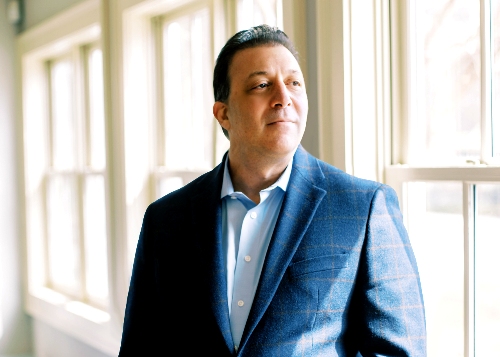The ongoing negotiations between SAG-AFTRA actors union and the studios, carefully analyzed through the lens of AI revenue expert Jeff Pedowitz, offer invaluable insights into the future of Hollywood and the potential resolution of this conflict. This is a must-read for all actors, writers and others, to arm yourselves with the information necessary to stand up for your rights and fight back.
Jeff Pedowitz is leveraging his profound understanding of AI and its potential impact on Hollywood, and provides invaluable insights into the ongoing negotiations between both parties. Analyzing the arguments and strategies put forth by SAG-AFTRA and the studios, Pedowitz offers a deeper understanding of the ramifications of incorporating AI into the entertainment industry.
AI Revenue Expert Jeff Pedowitz
LA’s The Place: How do you foresee AI impacting jobs in the entertainment industry, particularly in Hollywood, and what measures can be taken to mitigate potential job displacement?
Jeff Pedowtiz: AI’s impact on the entertainment industry, including Hollywood, is expected to be significant, as it has the potential to streamline various aspects of production and post-production, and even creative processes.
AI can automate tasks such as editing, sound mixing, and visual effects. It can also help in the scriptwriting process by analyzing data from successful movies and predicting what elements might make a film popular. However, these capabilities could potentially lead to job displacement for those involved in these areas.
But it’s important to note that while AI can automate certain tasks, it does not replace the need for human creativity, intuition, and decision-making. The creative force behind story creation, performance, and directing is a uniquely human skill that machines cannot replicate.
To mitigate potential job displacement, the entertainment industry should focus on upskilling and reskilling its workforce. People working in areas that may be affected by AI should be trained in how to work with these technologies, rather than be replaced by them.
Education around AI should also be promoted so that everyone in the industry, from performers to behind-the-scenes staff, understands the potential and limits of AI. With this knowledge, they can better adapt to the changing landscape.
In addition, industry decision-makers should consider ethical guidelines on the use of AI, particularly focusing on preserving employment and promoting cooperation between human workers and AI technologies.
While AI will undoubtedly bring changes to jobs in Hollywood, with thoughtful measures and a focus on adaptation and education, the industry can mitigate potential job displacement and make the most of the opportunities AI offers.
LATP: Can you elaborate on the potential revenue generation that AI offers to the entertainment industry?
Jeff: AI offers significant potential for revenue generation in the entertainment industry in several ways:
Content Personalization and Recommendation: AI can analyze vast amounts of data on viewer preferences and behaviors to provide highly personalized content recommendations, keeping viewers engaged and increasing the likelihood of subscription renewals or additional purchases. This can also inform the development of new content, reducing the risk of investing in productions that don’t resonate with audiences.
Predictive Analytics: By predicting trends and viewer preferences, AI can help producers make data-driven decisions on what types of films or shows to produce, leading to more profitable content creation.
Automated Content Creation: While human creativity is irreplaceable, AI can assist in creating content, particularly for repetitive tasks in animation or visual effects. This can reduce costs and expedite production times, allowing for a faster turnaround of content and, consequently, more regular revenue streams.
Ad Optimization: AI can optimize ad placements and pricing in real-time based on viewer data, maximizing ad revenue. This is particularly relevant for free, ad-supported platforms.
Virtual Reality and Augmented Reality: AI is a crucial component in developing immersive VR and AR experiences. As these technologies gain popularity, there are growing opportunities for monetization through premium experiences, in-app purchases, or advertising.
Content Protection: AI can help detect and prevent piracy or unauthorized distribution of content, protecting the industry’s revenues.
Direct Audience Engagement: AI-driven chatbots and virtual assistants can interact directly with audiences, providing interactive experiences, promoting merchandise, or even selling tickets.
By leveraging these opportunities, the entertainment industry can use AI to generate significant additional revenue, reduce costs, and streamline operations, making it a highly valuable tool in an increasingly competitive landscape.
LATP: How can studios leverage AI while ensuring fair compensation for actors and writers?
Jeff: The use of AI in studios brings about opportunities for efficiency and innovation but also raises questions about fair compensation for actors and writers. Here are a few ways studios can leverage AI while still ensuring fairness:
Recognizing Unique Contributions: While AI can assist in scriptwriting and even perform CGI-based acting, it’s crucial to remember that these technologies are tools, not replacements for human creativity. Actors’ unique performances and writers’ distinctive storytelling skills are what truly bring a script to life. Studios must ensure that these contributions are acknowledged and compensated appropriately, regardless of AI’s role in the process.
Collaboration, Not Replacement: AI should be seen as a collaborative tool that enhances actors’ performances and writers’ scripts rather than replaces them. For instance, AI can help generate ideas or plot points, but the crafting of engaging dialogue and narratives should be credited to the writers. Similarly, while AI can help choreograph complex scenes or animate CGI characters, the underlying performances should be attributed to the actors.
Adapting Contracts and Guild Rules: As AI becomes more prevalent, contractual terms and guild rules may need to be updated to reflect new working practices. This could include clauses around AI-assisted performances or scripts, and how these contribute to final compensation.
Training and Upskilling: Studios can invest in training programs for actors, writers, and other staff to learn how to effectively work with AI tools. This can create a more adaptable workforce and open up new creative possibilities, potentially leading to new forms of compensation and revenue sharing.
Ethical AI Use: Establishing guidelines for ethical AI use can also help ensure fairness. These guidelines should cover issues such as transparency (making it clear when and how AI is used), accountability (ensuring humans are involved in decision-making processes), and fairness (avoiding biases in AI algorithms).
In short, the key to leveraging AI while ensuring fair compensation for actors and writers is to use the technology as a collaborative tool that enhances, rather than replaces, human creativity, and to clearly define the rules and guidelines for this collaboration.
LATP: In the context of AI-generated performances, what are your thoughts on intellectual property rights?
Jeff: Intellectual property rights in the context of AI-generated performances represent an evolving and complex issue. Here are some thoughts:
Attribution: The question of who owns the IP rights of AI-generated performances can be challenging. If AI is used as a tool by human creators, those creators typically retain the IP rights. However, if an AI system independently creates a performance, the question of ownership becomes less clear.
Rights of Performers: When AI is used to recreate a performance or likeness of an actor, the actor’s IP rights should be respected. This means not using their likeness without explicit permission, and providing compensation where agreed. Actors should have control over how their likeness is used, and any usage should be outlined clearly in contracts.
Using AI-generated images of background actors without their permission or compensation raises important ethical and legal considerations. Here’s how studios can approach this issue:
Seek Permission: Before using AI to generate images of any actor, background or otherwise, studios should obtain explicit consent. This could be incorporated into contracts when background actors are hired. It’s important to clearly outline how and where their likeness will be used, both in the immediate production and potentially in the future.
Compensation: If a background actor’s likeness is used beyond the initial production they were hired for, it’s fair practice to compensate them. The terms of this compensation should be outlined in the initial contract. This may require new ways of thinking about contracts and compensation, particularly as AI and deepfake technology continue to evolve.
Ethical Guidelines: Studios should develop and adhere to ethical guidelines for the use of AI and deepfake technology. This should include rules around respect for individuals’ likeness and privacy.
Legal Considerations: Laws regarding the use of a person’s likeness vary from region to region, and many jurisdictions are still working out how to handle the implications of AI and deepfake technology. It’s crucial for studios to understand and adhere to all relevant laws and regulations, and to consider the potential legal risks of using AI-generated images without consent or compensation.
AI as a Tool vs. AI as a Creator: There’s a clear difference between using AI as a tool to aid human creation, and using AI as a creator in its own right. Current IP laws typically cover the former, with the human user of the tool retaining IP rights. But as AI capabilities grow, laws and regulations may need to evolve to address situations where AI functions more independently.
Legal Adaptations: As AI technology continues to evolve, so too must the legal frameworks that govern its use. We may see the development of new laws and regulations specifically designed to address the unique issues posed by AI-generated performances.
Ethical Considerations: Regardless of the legal landscape, studios and other creators using AI should consider ethical implications. This includes respecting the rights of human performers, providing fair compensation, and being transparent about the use of AI.
In short, the intersection of AI-generated performances and IP rights is complex and still unfolding. It’s essential for those using AI to keep abreast of both legal and ethical considerations as they navigate this evolving field.
LATP: How can actors and writers protect their creative contributions in a landscape increasingly dominated by AI?
Jeff: As AI becomes more prevalent in the entertainment industry, actors and writers can take several steps to protect their creative contributions:
Understand AI: Knowledge is power. Understanding how AI is used in the industry can help actors and writers navigate changes, take advantage of new opportunities, and protect themselves from potential pitfalls. This might involve participating in industry workshops or courses, or simply staying informed about industry trends.
Contract Clarity: When entering into contracts, ensure that terms regarding the use of AI and rights to your work or likeness are clearly defined. It’s essential to specify who owns the rights to any AI-augmented work and to negotiate appropriate compensation for any future use of your likeness or work.
Professional Representation: Agents or legal representatives can help ensure that contracts are fair and protect your rights. They can help you understand the potential implications of AI in contract negotiations and ensure you’re adequately compensated for your work.
Reskill and Upskill: Adapt to the changing landscape by learning new skills that complement AI technologies. For example, writers could learn how to use AI tools to enhance their storytelling, while actors might train in motion capture techniques used in AI-assisted animation.
Participate in Industry Discussions: As the industry grapples with the implications of AI, contributing to the conversation can help shape the future in ways that protect and benefit creatives. This could be through guild or union involvement, participating in industry forums, or advocating for ethical guidelines around AI use.
Protect Your Work: Register your work to protect it under copyright laws. While this may not cover all AI-related issues, it provides a legal basis for protecting your creative contributions.
While AI can automate certain tasks, it does not replace the creativity and emotion that humans bring to the arts. Emphasizing the unique, irreplaceable value of human creativity can help actors and writers protect their roles in a rapidly evolving industry.
Lessons from the Napster Era
The rise of Napster and file-sharing in the late ’90s and early 2000s forced a seismic shift in the music industry. Initially, the industry responded with lawsuits and attempts to shut down these services. However, as it became clear that digital distribution was not a passing trend, the industry adapted. The result was the development of legal digital platforms like iTunes and later Spotify, which monetized digital music while also providing consumers with easy access to songs and albums.
There are distinct parallels with AI’s impact on the entertainment industry today:
Resistance: Much like the music industry’s initial resistance to digital distribution, some segments of the entertainment industry may resist the changes brought about by AI, particularly due to fears of job displacement or loss of creative control.
Legal and Ethical Concerns: The legal battles around Napster echo today’s discussions about the ethical use of AI, particularly around issues like the use of an actor’s likeness or AI-generated performances. The industry will need to navigate these issues, potentially leading to new laws or norms.
Adaptation and Innovation: Eventually, the music industry found ways to adapt to and profit from digital distribution. Similarly, the entertainment industry has the potential to adapt to AI, using it as a tool to enhance creativity, improve efficiency, and create new forms of entertainment. This might involve new ways of working, new business models, or new types of contracts and compensation.
Consumer Behavior Changes: Napster fundamentally changed how people consumed music. AI also has the potential to change how people consume entertainment, perhaps through personalized content, interactive media, or other yet-to-be-imagined innovations.
The entertainment industry can learn from the music industry’s experience with Napster. Resistance to change is often futile and adaptation is key. Ethical and legal issues need to be navigated carefully, but with creativity and a willingness to embrace new models, the industry can use AI as a powerful tool for growth and innovation.
LATP: When it comes to the effectiveness of AI versus human actors and writers, what advantages and limitations do you see for each? Is there a balance that can be struck between AI and human creativity?
Jeff: AI and human actors and writers each bring unique strengths to the table, as well as certain limitations.
Advantages of AI:
Efficiency and Speed: AI can process and generate information much faster than humans, which can help expedite certain creative processes, such as drafting scripts or generating animation.
Big Data Analysis: AI can analyze massive amounts of data, identifying trends and patterns that might not be readily apparent to humans. This can inform decisions about what kind of content to produce.
Repetition and Consistency: AI can perform the same task consistently without fatigue, which can be useful in certain areas, like editing or animating repetitive sequences.
Limitations of AI
Lack of Creativity: While AI can mimic patterns and generate content based on existing data, it does not possess the same kind of creative instinct and emotional understanding that humans do. This is vital in storytelling and performance.
Ethical and Legal Concerns: The use of AI raises complex ethical and legal issues, particularly around intellectual property rights and the use of individuals’ likenesses.
Advantages of Human Actors and Writers
Emotion and Creativity: Humans bring emotional understanding, creative insight, and intuition to their work, qualities that AI cannot replicate.
Unique Perspective: Each actor and writer brings their unique perspective and experiences to their work, creating a rich variety of content.
Adaptability: Humans are highly adaptable, able to react to unexpected changes or shifts in the creative process.
Limitations of Human Actors and Writers
Time and Resource Constraints: Human creative processes often take more time and can be subject to physical or emotional constraints.
Subjectivity: While often a strength, the subjective nature of human creativity can also lead to inconsistencies, disagreements, or bias.
Striking a Balance
The ideal scenario in the evolving landscape of entertainment is a balance where AI serves as a tool to augment and enhance human creativity. AI could handle data analysis, tedious or repetitive tasks, and provide suggestions or options, allowing human actors and writers to focus more on the creative and emotive aspects of their work. This collaborative model could capitalize on the strengths of both AI and human creatives, while minimizing limitations.
LATP: Could you shed some light on the current growth trends in the AI industry, and how these trends might influence the ongoing negotiations between SAG-AFTRA and the studios?
Jeff: The AI industry is expanding rapidly, with applications spanning diverse sectors. In the entertainment industry, AI is being leveraged for scriptwriting, deepfakes, CGI, and even predicting audience preferences, fundamentally transforming traditional processes.
SAG-AFTRA’s ongoing negotiations with studios could be influenced by these AI trends in multiple ways:
Job Security: As AI becomes more capable of performing tasks traditionally done by humans, members might fear job displacement. These concerns could push the union to demand job security guarantees or compensation schemes for affected roles.
Compensation Models: The use of AI in performance and content creation raises questions about how artists are compensated. If an actor’s digital likeness is used, for instance, how should they be paid? SAG-AFTRA will likely address these complexities, pushing for fair compensation models for work involving AI.
Working Conditions: As AI changes the way projects are created and produced, it could also impact working conditions. This might include everything from hours on set to how performances are captured and reproduced. These shifts could feature in union demands for improved working conditions.
Training and Upskilling: If AI is changing the skills needed in the industry, SAG-AFTRA might advocate for training programs to help members adapt, ensuring they can continue to find work in an AI-influenced industry.
Ethical and Legal Protections: The union could push for ethical guidelines and legal protections around the use of AI, particularly regarding the use of an individual’s likeness.
The growth of AI could significantly influence SAG-AFTRA’s negotiations, shaping discussions around job security, compensation, working conditions, and more. The result will be a new agreement adapted to the realities of this rapidly evolving industry.
LATP: Considering the potential risks associated with AI implementation, how can a thorough risk assessment be conducted to ensure the responsible and ethical use of AI in the entertainment industry?
To conduct a thorough risk assessment for the responsible and ethical use of AI in the entertainment industry, several key steps should be followed:
Define AI Applications: The first step is to clearly define where and how AI is being used. This could range from scriptwriting to post-production effects, or even to predicting audience behavior.
Identify Potential Risks: Once AI applications are defined, potential risks must be identified. This could include risks related to job displacement, misuse of personal likeness, copyright infringement, data privacy, biases in AI algorithms, and more.
Assess Impact and Probability: Each identified risk should be assessed based on its potential impact and the probability of occurrence. For example, misuse of personal likeness could have a high impact on an individual’s privacy and reputation, and if there are not strong safeguards in place, it might also have a relatively high probability of occurrence.
Develop Mitigation Strategies: For each risk, a mitigation strategy should be developed. This might involve technical solutions, like better data privacy protections, policy solutions, such as clearer contracts regarding the use of personal likeness, or training programs to help industry professionals adapt to new AI tools.
Implement and Monitor: After the risk assessment is completed and mitigation strategies are developed, these strategies should be implemented and regularly monitored for effectiveness. The risk environment should also be re-assessed periodically, as the technology and its use in the industry continue to evolve.
Consultation and Transparency: It’s important to consult with stakeholders (actors, writers, directors, etc.) throughout this process to understand their concerns and get their input. Moreover, being transparent about how AI is used and the steps taken to mitigate risks can build trust and lead to more ethical and responsible AI use.
This process will help to ensure that the implementation of AI in the entertainment industry is done in a way that respects individuals’ rights, minimizes harm, and maximizes benefits.
LATP: What role do you believe AI can play in enhancing creativity in filmmaking and storytelling? Can it coexist and collaborate with human artists to push the boundaries of creativity?
Jeff: AI holds immense potential to enhance creativity in filmmaking and storytelling, and it can certainly coexist and collaborate with human artists. Here’s how:
Data Analysis: AI can analyze vast amounts of data quickly and accurately. In the context of filmmaking, this could translate into identifying trends, understanding audience preferences, and providing insights into what type of content resonates with viewers.
Automating Tedious Tasks: Many parts of the filmmaking process can be labor-intensive and repetitive. AI can automate some of these tasks, like certain aspects of editing or CGI, freeing up artists to focus more on the creative aspects of their work.
Scriptwriting and Storytelling: AI algorithms can generate script ideas and storylines based on existing data patterns. While these may not replace human writers, they can serve as creative tools, sparking new ideas or suggesting different angles.
Performance Capture and Animation: AI can also help in the areas of performance capture and animation. Through machine learning, AI can generate realistic animations based on captured performances, helping to streamline the animation process and increase its realism.
Personalization: AI can also enable more personalized storytelling. For instance, algorithms could adjust a story in real-time based on the viewer’s reactions, creating a unique and interactive viewing experience.
AI should be viewed as a tool in the artist’s kit, augmenting human creativity rather than replacing it. By leveraging AI, filmmakers and storytellers can push the boundaries of creativity, delivering content that is compelling, immersive, and engaging in new ways. The future of filmmaking and storytelling could be a collaboration between human creativity and artificial intelligence, combining the best of both to create truly innovative art.
LATP: AI is often seen as a cost-saving measure for studios and streaming services. In what ways can AI be effectively utilized to reduce production costs while still maintaining the artistic integrity of films and TV shows?
Jeff: AI can be a valuable tool for studios and streaming services looking to reduce costs while maintaining artistic integrity. Here’s how:
Pre-Production Planning: AI can analyze historical data to provide predictive analytics for a project’s success, helping producers make informed decisions about which scripts to greenlight. This can save significant costs that might have otherwise been spent on less successful ventures.
Script Breakdowns and Scheduling: AI can automate the process of script breakdowns and scheduling, tasks that are traditionally time-consuming. By optimizing the schedule for shooting days, locations, and actors, AI can contribute to considerable cost savings.
Casting: AI can streamline the casting process by scanning through vast amounts of actor portfolios and suggesting suitable choices based on character descriptions. This speeds up casting and reduces costs associated with traditional casting processes.
Post-Production: AI can be particularly useful in post-production. AI-driven software can handle tasks like color grading, sound editing, and visual effects more efficiently, reducing the hours needed for human intervention. This not only accelerates the post-production process but also cuts down on costs.
Marketing: AI can optimize marketing spend by analyzing viewer behavior and preferences to determine the most effective marketing channels and strategies. This ensures that promotional budgets are used effectively, yielding better returns on investment.
Personalized Content Recommendations: For streaming platforms, AI can personalize content recommendations, increasing viewer engagement and retention. While this may not directly reduce production costs, it can increase revenue and viewer satisfaction, improving the overall cost-effectiveness of the platform.
While AI can contribute to cost savings, it’s important to remember that the human touch is essential in creating compelling narratives and performances. Therefore, AI should be viewed as a tool to assist and streamline processes, not to replace the unique human input that is central to creative storytelling.
LATP: From an ethical standpoint, what considerations should be taken into account when it comes to the usage of AI in the entertainment industry? How can potential ethical challenges be addressed?
Jeff: When it comes to the ethical use of AI in the entertainment industry, several key considerations should be taken into account:
Data Privacy: AI often relies on large volumes of data, including personal data from audiences and possibly even artists. Ensuring this data is collected, stored, and processed ethically and legally is critical. This might involve obtaining informed consent, anonymizing data where possible, and using secure storage and processing methods.
Fair Compensation: If an actor’s digital likeness or an artist’s creative work is used by AI, how should they be compensated? It’s important to create fair compensation models that recognize the contributions of all involved, particularly as AI blurs the line between human and machine-created work.
Bias and Discrimination: AI systems can unintentionally perpetuate or amplify existing biases if they’re trained on biased data. In the context of entertainment, this could affect everything from which scripts get greenlit to how audiences are targeted. It’s crucial to monitor for and mitigate these biases.
Job Displacement: As with any industry where AI is being introduced, there’s concern about job displacement. Ensuring a just transition for those whose jobs are changed or eliminated due to AI is a significant ethical consideration.
Intellectual Property Rights: Clear policies and laws should be in place to protect the intellectual property rights of creators in the face of AI technology, especially as AI begins to create its own content.
Addressing these ethical challenges involves a combination of technical solutions, policy and legal frameworks, and ongoing dialogue with all stakeholders, including artists, audiences, and AI developers. Regular ethical audits of AI systems, coupled with transparency about how AI is used, can also help maintain ethical standards. Lastly, training and education can help all involved navigate these complex issues as AI becomes more ingrained in the industry.
LATP: As AI becomes more prevalent in the industry, how important is retraining and upskilling for actors, writers, and other industry professionals to adapt to the changing landscape? What resources and support should be provided?
Jeff: The increasing prevalence of AI in the entertainment industry makes re-training and upskilling crucial for actors, writers, and other industry professionals. As AI changes how content is created and distributed, these professionals need to understand how to leverage these tools effectively and navigate the changing landscape. Here are some ways to support this:
Education Programs: Industry-specific education programs about AI can provide professionals with a better understanding of AI capabilities, applications, and limitations. This might include workshops, seminars, online courses, or even degree programs.
Training in New Tools: As AI tools become more common, training programs can help professionals become adept at using them. This could involve everything from AI-enhanced scriptwriting tools to performance capture technologies for actors.
Adaptation to New Roles: AI might alter or create new roles within the industry. For instance, professionals might need to adapt to roles that involve working closely with AI systems or managing these systems. Providing training and support for these new roles can help industry professionals adapt.
Unions and Professional Organizations: These organizations can play a vital role in advocating for their members, negotiating for training support in contracts, and providing resources and information about AI.
Mentorship and Peer Learning: Encouraging a culture of peer learning and mentorship can also be beneficial. Those who have successfully adapted to using AI in their work can provide valuable guidance to their peers.
In essence, as AI technologies continue to evolve, ongoing learning and adaptability will be key. By providing adequate resources, training, and support, the industry can help ensure that its professionals are well-equipped to navigate this changing landscape.
LATP: Do you believe that regulations specific to AI implementation in the entertainment industry are necessary? What measures should be in place to ensure fair and responsible AI usage?
Jeff: Yes, specific regulations around AI implementation in the entertainment industry can be beneficial to ensure fair and responsible use. Although AI presents numerous opportunities for the sector, it also raises unique challenges that general regulations may not adequately address. Here are some measures that could be considered:
Data Privacy and Security Regulations: These regulations would ensure that personal data collected and used by AI systems are adequately protected. They could include requirements around obtaining informed consent, anonymizing data, and using secure data storage and processing methods.
Bias and Fairness Standards: These would aim to ensure that AI systems do not perpetuate or amplify existing biases, which could impact everything from casting decisions to audience targeting. Standards might involve requirements around the diversity and representativeness of training data, as well as regular auditing of AI systems for bias.
Intellectual Property Rights: Clear regulations are needed to define who owns AI-generated content and how artists are compensated for the use of their work or likeness by AI. This could involve updating copyright laws to account for AI, and establishing fair compensation models.
Job Transition Policies: Given the potential of AI to disrupt jobs in the entertainment industry, policies could be put in place to support those affected. This might include requirements around retraining and upskilling support, as well as measures to promote job creation in new areas related to AI.
Transparency and Accountability Requirements: Regulations could require companies to be transparent about how and when they’re using AI, and hold them accountable for its impacts. This might include disclosing when AI is used in content creation or audience targeting, for example.
Ethics Guidelines: Clear guidelines around the ethical use of AI in entertainment could be developed, covering issues like the responsible use of AI-generated images of people, or the use of AI in creating deepfakes.
These regulations and standards would need to be developed in close consultation with all stakeholders, including industry professionals, AI developers, and audiences, and would need to be regularly updated as AI technology continues to evolve.
LATP: With your extensive experience in business growth through technology, what key insights or recommendations do you have for both SAG-AFTRA and the studios as they navigate the complexities of incorporating AI in Hollywood?
Jeff: Incorporating AI into Hollywood presents exciting opportunities, but it’s critical to approach this transformation with a strategic and mindful perspective. Here are my key insights and recommendations for both SAG-AFTRA and the studios:
Embrace Collaboration: It’s important that all parties involved – studios, unions, artists, technologists – have open lines of communication. The development of AI in Hollywood is not a zero-sum game. When done right, it benefits everyone involved.
Focus on Education and Training: As AI is increasingly integrated into the industry, it’s crucial to ensure that industry professionals understand this technology. Regular workshops, seminars, and training sessions can help demystify AI and empower individuals to make the most of these tools.
Invest in Ethical and Responsible AI: AI can be a powerful tool, but it also comes with ethical considerations. It’s important to prioritize the responsible use of AI, including transparency, fairness, data privacy, and avoiding bias. Investing in AI ethics can mitigate potential issues and increase trust among all stakeholders.
Prioritize Fair Compensation Models: As AI begins to blur the lines of who or what creates content, it’s vital to develop fair compensation models. This is particularly crucial when using AI technology that relies on an actor’s digital likeness or a writer’s unique style
Use AI to Enhance, Not Replace: The goal of AI should not be to replace human creativity, but to augment it. AI can take on routine tasks, provide data-driven insights, and even assist with creativity, but the core of storytelling and emotional resonance in entertainment is uniquely human.
Stay Ahead of the Regulatory Curve: Anticipating and adapting to potential changes in regulations related to AI can help avoid future issues. Participate in policy discussions and advocate for reasonable, industry-friendly rules that protect all stakeholders.
The transformation brought on by AI is a journey. It’s an ongoing process that will require adaptability, foresight, and continued learning from all parties involved. By adopting these practices, SAG-AFTRA and the studios can navigate this transformation in a way that benefits everyone in the industry.
LATP: What would you say to the studios who are already losing money on streaming and are taking a hard line position in even responding to sag-aftra?
Jeff: In the current landscape, studios face financial challenges due to the disruptive nature of streaming models and the massive investment in content creation required. Monetizing this investment, especially without advertising revenue, and addressing the changing nature of work in the entertainment industry presents significant challenges.
Understandably, with financial pressures and costs of running the business, engaging with SAG-AFTRA over AI might seem like an additional strain. However, I urge studios to see this not as an added burden, but as a pathway towards a more sustainable and profitable future.
When leveraged strategically, AI can enhance efficiency, reduce costs, and open up new revenue opportunities by providing valuable insights for smarter investment decisions in content. It could help analyze viewing patterns, preferences, and trends, ensuring that investments are targeted effectively.
Simultaneously, open communication and collaboration with SAG-AFTRA could provide a competitive advantage. Such proactive engagement could help navigate potential challenges related to AI, including regulatory issues and ethical considerations, thereby avoiding costly pitfalls in the future.
New revenue models can be explored, such as tiered subscriptions, limited advertising options, or even licensing content to other platforms post exclusivity periods. This collaborative approach could also lead to the redefining of contracts that provide stability for artists while allowing for the flexibility required in the streaming landscape.
Investing in talent, both in front of and behind the camera, can lead to high-quality content that attracts viewers. Collaborating with SAG-AFTRA can ensure that talent is nurtured and compensated fairly, contributing to better content and stronger relationships. Beyond subscriptions, studios can also leverage their platforms for merchandise sales, virtual events, or experiences tied to their content, generating additional revenue and increasing audience engagement.
While immediate financial pressures are real, viewing AI as a growth tool, taking a step back to see the bigger picture, embracing change, and fostering collaboration could lead to innovative solutions that benefit everyone involved in the long run. The future of entertainment lies in this approach, prioritizing people – the artists, and maintaining good relationships with them for long-term success.
Feature photo by Genie Music









